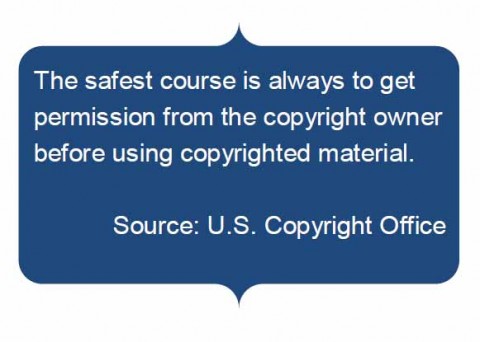At the heart of the Fair Use principle—the idea that there are times when you don’t need someone’s permission to use part of their material in something you’re publishing—is Section 107 of U.S. copyright law. It has four basic elements, as laid out by the U.S. Copyright Office:
“Section 107 contains a list of the various purposes for which the reproduction of a particular work may be considered fair, such as criticism, comment, news reporting, teaching, scholarship, and research. Section 107 also sets out four factors to be considered in determining whether or not a particular use is fair:
1. The purpose and character of the use, including whether such use is of commercial nature or is for nonprofit educational purposes
2. The nature of the copyrighted work
3. The amount and substantiality of the portion used in relation to the copyrighted work as a whole
4. The effect of the use upon the potential market for, or value of, the copyrighted work”
If you think that’s pretty straightforward, you would be wrong. For there is no list of uses “that are always and under all circumstances permitted under the doctrine of fair use,” notes Michael C. Donaldson, author of “Clearance & Copyright.” (Another good book to learn more about this field.) “The language does not give definitive guidance even to the courts, let alone the layperson.”

Even the Supreme Court has left the matter fairly fuzzy, saying in effect that all factors need to be considered and weighed. One thing seems pretty certain: Fair Use is not a license to “poach,” says Donaldson. “Fair use allows you to create something new and different using someone else’s creation as an ingredient, a single element in a new mix.”
There are no conceptual shortcuts in this area—no brain tubes as in the movie “Matrix” to give you an instant understanding of the copyright law’s complexities. But there are some guides than can at least make the subject clearer.
The Center for Social Media at American University is a virtual one-stop shop for guidance about copyright and fair use. Two documents are particularly helpful:
- The Code of Best Practices in Fair Use for Online Video, “a code of best practices that helps creators, online providers, copyright holders, and others interested in the making of online video interpret the copyright doctrine of fair use.”
- The Documentary Filmmakers’ Statement of Best Practices in Fair Use (PDF), “shows when and how it is legal to use copyrighted material within a documentary film.” Fittingly, there’s also a short companion film about the report.
You’ll find many other publications there for further reading on this critical topic.



